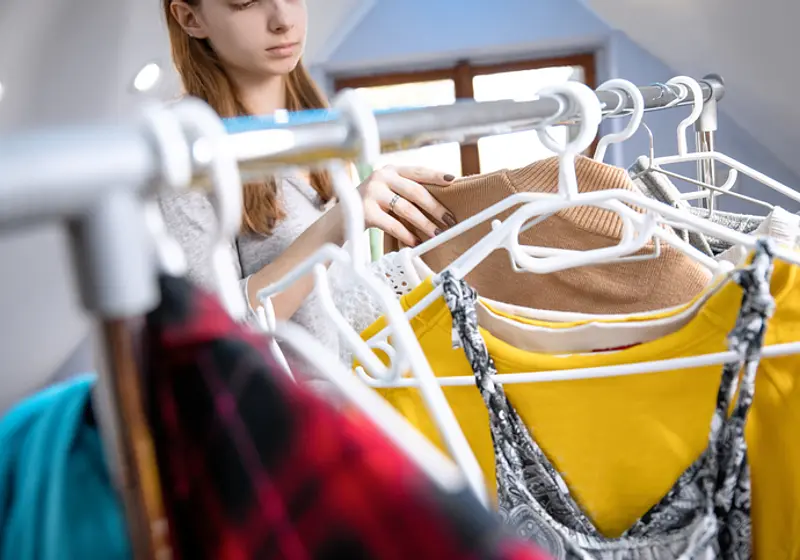The relationship between our clothing and emotional states goes way beyond mere aesthetics. Whether it’s a sharp suit exuding confidence to cozy sweatpants for comfort, our wardrobe choices can greatly influence how we feel, behave, and are perceived in various situations.
Fashion's Influence on Teenagers
The Power of the Right Outfit
For many teenagers, the right outfit can act as a psychological boost and enhance their self-esteem as they navigate the challenges of adolescence. Beyond being a simple wardrobe, the right clothing can become a symbolic representation of self-identity, influencing how teenagers perceive themselves and how they want to be viewed by others.
However, the pressure to conform to beauty standards can lead to both positive and negative outcomes, majorly influencing social dynamics and self-esteem within teen life. While a carefully picked outfit can instill lots of confidence, societal expectations can also cause negative outcomes, leading to feelings of insecurity or self-doubt among teenagers.
The fashion choices made by teens can signal their group affiliations, helping them form connections with like-minded peers. Fashion becomes a language through which many teenagers can find a sense of belonging, helping to build friendships, romantic relationships, and social networks.

Image Credit: William Perugini from iStock
Impact of Social Media on Teen Fashion Trends:
Social media has significantly transformed the fashion industry, with platforms such as Instagram, TikTok, and YouTube playing pivotal roles in shaping trends and influencing the choices of teenagers. The rise of social media has particularly impacted the dynamics of fast fashion.
Influencers with great followings on these platforms have a lot of influence over fashion trends, dictating what's “hot or not”, and guiding the preferences of today's youth. Rita Campo Griggs, Fashion Director and Instructor at Palomar College, with experience in orchestrating numerous fashion shows for renowned designers like Bill Blass, Liz Claiborne, and Calvin Klein, highlights the major role social media plays in trendsetting.
According to Griggs, "Social media is the driving force behind fashion trends. If it doesn't make it to social media, it won't become a trend." The desire to emulate celebrities and influencers has become a big factor in teenagers seeking style inspiration and gaining confidence in their fashion choices, and platforms like Instagram and TikTok encourage these trends, fostering a rapid adoption of new styles.
Fashion and Mental Health
While fashion can be a great tool for positive self-expression and confidence, it can also be a major source of stress and insecurity. Mental illnesses such as anxiety, depression, and body dysmorphia can all lead to an unhealthy fixation on one’s appearance. This can lead to a very dangerous cycle of teenagers losing confidence, comparing themselves to unrealistic standards, and even beginning to hate themselves.
Certainly, fashion can be a great way to boost confidence and express themselves for many teenagers. However, when feeling self-conscious or uncomfortable in their own bodies, teens can start to form negative feelings about themselves and start to question their self-worth. While feeling low or depressed, teens may not feel like dressing up or making any efforts to look nice. Some may also use their fashion choices as a way to blend in or hide their insecurities, often choosing comfort over style to cover up.

Image Credit: Anna Frank from iStock
Impact of Clothes on Academics
Believe it or not, fashion has such a powerful impact on teenager’s everyday lives, it even affects how teens do well academically. A 2016 study conducted by the Iowa State University stated that students tend to be more engaged in the classroom when wearing more professional clothing, opposed to being attired in leisure wear. Obviously you don’t need to show up in high heels and a dress for exam day, but it has been proven that dressing up for test taking can often lead to scoring higher grades and put students in the right mindset.
When you are dressed up, you feel more confident and sure of yourself. This perception is why there are dress codes at workplaces, fancy restaurants and sometimes schools. The same reasoning can be applied to taking exams, as dressing more formally can improve students’ academic performance. Wearing a stylish top or your best shoes to school could boost your confidence and help score higher, because just as clothing affects people’s perceptions of you, it can also shape your perception of yourself.
Clothing and Sense of Self
Fashion’s Role in Self-Perception
Psychologist Michelle Pal’s study on fashion psychology showed that clothing choices can often have ties with a person’s sense of self, and these choices become crucial during the important years of adolescence. Teenagers find their clothing preferences play a big role in shaping their self-perception and influencing their interactions with the world.
This is called “enclothed cognition”, a psychological phenomenon that describes how clothing can influence the wearer’s psychological processes. Basically, if you look good, you feel good.
“Our self-care or little habits, like dressing up or putting on makeup, tend to be one of the first things to drop off when feeling stressed or depressed,” Pal said, emphasizing how teens also use fashion to reflect their emotional well-being and self care.

Image Credit: iVazoUSky from Shutterstock
Balancing Conformity and Individuality
During adolescence, a period marked by self-discovery and gaining independence, teens use clothing to convey their evolving sense of self. The desire to fit in or stand out becomes intertwined with fashion choices, creating a balance between conformity and individuality. When you see someone in a nice suit or dress, you assume they are well put together or successful, whereas you might think the opposite when you see someone in baggy sweats or beat up clothes.
This way of thinking also applies in high school. As you are building your identity and showcasing your individuality to the world through your clothing choices and styles, fashion can also reflect your cultural background, personal interests, and aspirations, according to The Times of India. It is important to pick your clothes not only based on personal preferences, but also how you want to be perceived in the world.
Non-Verbal Communication and Identity
Expressing Personality and Identity
The significance of what we wear is not just liking a particular style; it plays a crucial role in shaping initial impressions. According to Science of People, "when it comes to communicating confidence and ability, what you wear plays an important role in creating positive first impressions." Research from Course Sidekick also suggests that clothing serves as a powerful form of non-verbal communication, expressing various aspects of one's personality and identity, as “a sloppy appearance, messy hair and wrinkled clothes may send the message: "I don't care," while appropriate attire demonstrates the importance of the occasion.” Clothing serves as a powerful form of non-verbal communication, expressing various aspects of one's personality and identity.

Image Credit: FG Trade Latin from iStock
Overall, the relationship between clothing and emotional states significantly influences teens. From the psychological impact of self-expression to the effects of "enclothed cognition," understanding the science behind clothing choices is essential in understanding and working through the complexities of teenage years. It is very important for teenagers to always stay true to themselves and find their own place in the world, and experimenting with different clothing and streetwear is a great way for self discovery and growth.

















